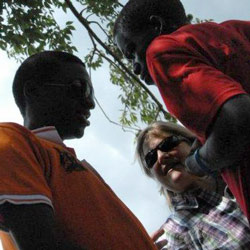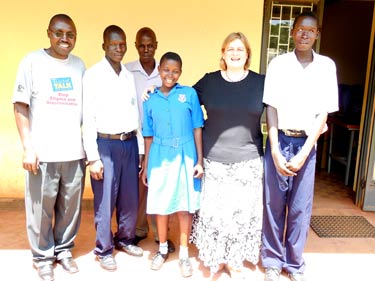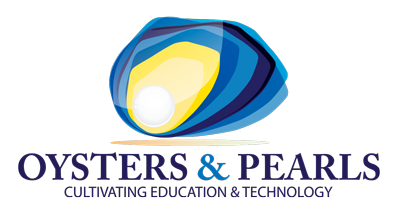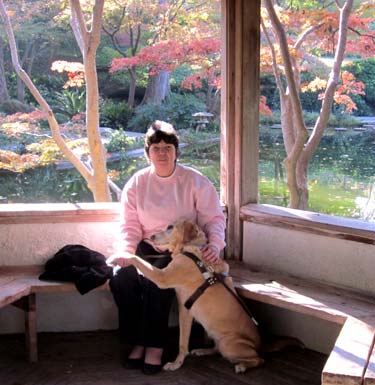Why this curriculum? Why Uganda? Why Oysters & Pearls?
Why this curriculum?
Oysters & Pearls is about integrating technology and science in schools that are inclusive of the blind. Oysters & Pearls is also an advocate of women and girls’ opportunities in education and sports as well as promoting wildlife conservation.
Why Uganda?
 Africa first came to my attention as a place I might like to know better when my Grandmother went on safari to Kenya. She was in her 60s and her voice was passionate and excited as she narrated the small square Kodak photos – bringing to life her first sightings of giraffe and lions and spending the night at Treetops. My grandmother was a huge influence on me. Her one regret was not attending college so she pushed me to complete my graduate degree. She was a true advocate for education. So my grandmother gave me two passions, Africa and education. My third passion is for philanthropy, and so with a background in social activist causes blending my three passions has created Oysters & Pearls.
Africa first came to my attention as a place I might like to know better when my Grandmother went on safari to Kenya. She was in her 60s and her voice was passionate and excited as she narrated the small square Kodak photos – bringing to life her first sightings of giraffe and lions and spending the night at Treetops. My grandmother was a huge influence on me. Her one regret was not attending college so she pushed me to complete my graduate degree. She was a true advocate for education. So my grandmother gave me two passions, Africa and education. My third passion is for philanthropy, and so with a background in social activist causes blending my three passions has created Oysters & Pearls.
Our days were spent getting to know the students and hearing about their challenges in working with limited tools. A fully-equipped student will have access to a computer with JAWS software which reads aloud the screen, a Perkins Brailler for taking notes or writing papers, a braille printer, a scanner, a talking calculator with headphones, a talking watch and more. At the Primary School, 26 students share 3 Perkins Braillers with limited supplies of Braille paper so that they can only use them to write final papers or exams. There is no computer, printer, talking calculator or talking watch. We provided white canes and taught them how to use them to navigate around campus independently rather than relying on sighted students to guide them.
I wish that you could see their gratitude for this small offering. They sang songs to us, using our names to express their gratitude for the white canes. They asked to visit again. I did go back again and brought more canes so that each student now has a cane. In November, when I returned alone, we called a meeting for 10 am at the Consolation Home to distribute the canes to the community members whom we had measured in June. As were approaching the Consolation Home by car, I noticed a woman with a baby strapped on her back using a cane. It was Abur Elizabeth, a young mother whose baby had malaria. She already had a cane but was coming to this training to show her gratitude and say hello. This really warmed my heart and gave me a thrill to know that our little program of direct aid was having an effect. So far, we’ve distributed 63 canes to the students and community members.
 It is estimated that about 1% of the population is blind; if this is true for Uganda’s 33-34M people, we would guess there could be nearly 350,000 blind people. But, Ugandan’s demographics are oddly out of sync with most Western countries – fully half are under 16 years old. Many cases of blindness in Uganda are considered preventable – side effects from measles, untreated eye infections and river blindness to name a few. Several agencies and NGOs are working hard to reduce the preventable causes by influencing public health policies and education of the population. In many areas, blindness is still viewed as a stigma or curse on the individual and his or her family, and as such is considered a waste of money to send a blind person to school. Oysters & Pearls is dedicated to the mission of changing perceptions by simply demonstrating that a blind person is just as capable as a sighted student, the educational tools and strategies are just different.
It is estimated that about 1% of the population is blind; if this is true for Uganda’s 33-34M people, we would guess there could be nearly 350,000 blind people. But, Ugandan’s demographics are oddly out of sync with most Western countries – fully half are under 16 years old. Many cases of blindness in Uganda are considered preventable – side effects from measles, untreated eye infections and river blindness to name a few. Several agencies and NGOs are working hard to reduce the preventable causes by influencing public health policies and education of the population. In many areas, blindness is still viewed as a stigma or curse on the individual and his or her family, and as such is considered a waste of money to send a blind person to school. Oysters & Pearls is dedicated to the mission of changing perceptions by simply demonstrating that a blind person is just as capable as a sighted student, the educational tools and strategies are just different.
Why Oysters & Pearls as our name?
Though often attributed to Winston Churchill, the phrase “Uganda is the Pearl of Africa” was most likely coined by journalist and explorer, Sir Henry Morton Stanley (Dr. Livingstone I presume.”) However, no matter who originally said it, it was the exquisite beauty of the country the “exceptional people” that impressed both men. The reason for the title Oysters & Pearls is that the oyster, a small living creature, can produce over time, a thing of beauty and value. A pearl takes input from its surrounding to give it its beauty, starting with a small grain of sand. So our students are our pearls, each one is unique, each reaches their own unique potential no matter where their path may be, and it is not for us to determine, we just want to give them the environment to flourish.
Thanks for reading about our program. Please Contact Me if you have any questions, and better yet, if you want to help!
Sandra Washburn

